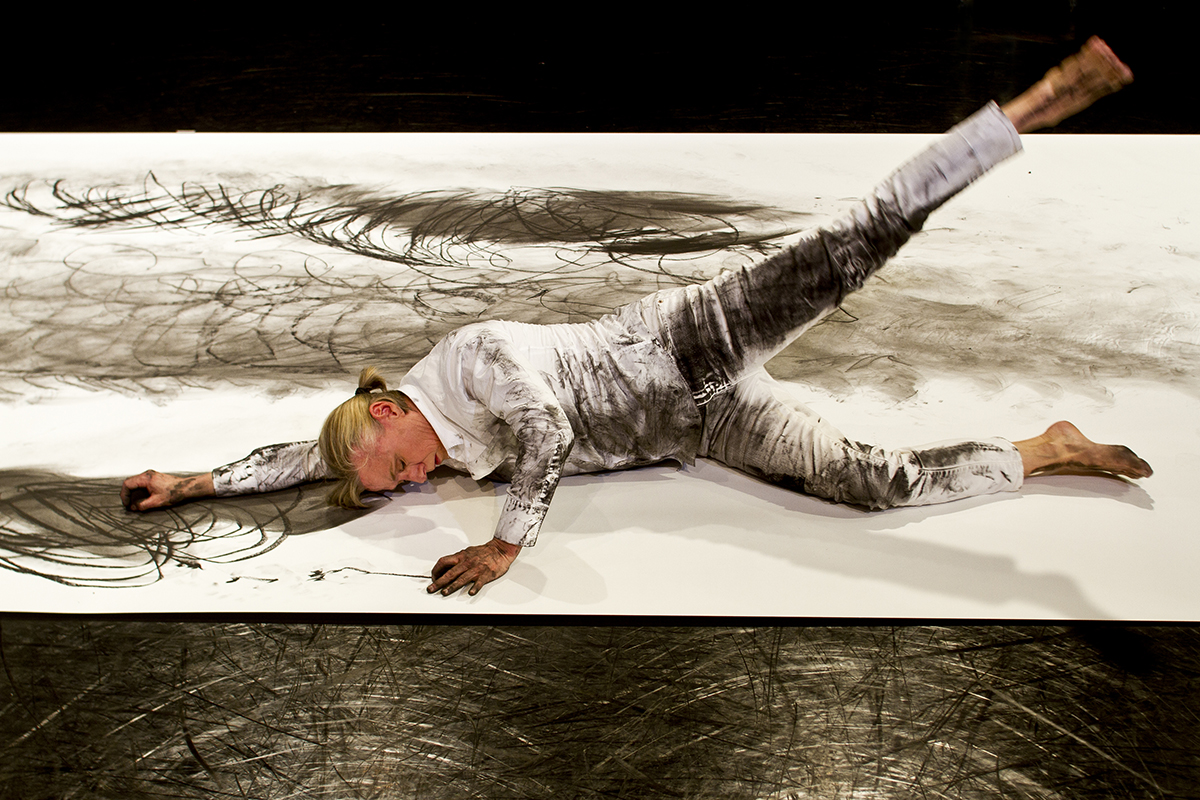
Photo by Mark Graham
Dance Leads to Therapeutic Potential
Nina Martin’s ReWire technique offers people with cerebral palsy some relief from their symptoms.
Susie Angel had few expectations when she signed up for a weekend workshop that Nina Martin taught in November 2014.
“Nina had us start with a warmup, doing something called Fussy Baby that we did on the ground,” said Angel, whose cerebral palsy keeps her in constant motion throughout her waking hours.
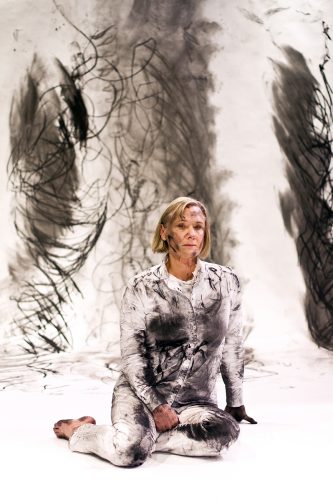
Nina Martin, associate professor of dance, after completing her piece “Secondary Surface Rendered” on white paper with charcoal. The performance has been done with dancers of mixed ability, including those with cerebral palsy. Photo by Mark Graham
“In the middle of that time, my body went still for something like 3 to 5 minutes, and it totally blew me away,” Angel said. “I was 44 years old, and that was the first stillness I had ever felt for any amount of time in my entire life.”
Like Angel, Tanya Winters experienced something powerful in Martin’s workshop. “People with CP like myself are functional movers. Our bodies and our minds are always involved, trying to put the pieces together,” Winters said. “During Fussy Baby, I noticed a general feeling of calm. My breathing was better afterward and so was my walking. My spine was straighter, and I felt this sense of elation.”
Martin, associate professor of dance, had no idea the practice she created based on a lifetime of work had any therapeutic potential. “I am an artist, not a therapist,” she said. “Here I had enough research to last me well beyond my mortal life, but this was something I felt duty bound to explore.”
Origins of a Theory
Since age 16, Martin has devoted her life to dance. As a modernist performer and theorist, she flourished as a dancer in New York City, ultimately pairing performance with teaching at New York University for about a dozen years. After moving to the West Coast in the 1990s, Martin taught at the University of California, Los Angeles and co-founded Lower Left, a San Diego-based postmodern performance collective.
Martin came to TCU in 2008, earning her doctorate from Texas Woman’s University five years later. For part of her dissertation, Martin examined her experiences with preconscious thought while improvising.
“I have spent a great deal of my professional life reading about cognitive science to try to understand exactly what was happening to me onstage,” Martin said. “I knew I wasn’t conscious of everything I was doing.”
Martin likened some of her movements to what happens when a person trips over a curb: Even before the conscious mind can formulate a plan of action to keep from falling, the body initiates “a complex action in order to right itself.”
Trying to access that preconscious movement state at will and on demand, Martin spent hours lying on the floor studying her nervous system. From that inquiry came a technique she named the ReWire Movement Method.
“ReWire came out of the idea of subverting the predictive aspect of our brain,” Martin said. “Because I was an improviser onstage, I was used to making rapid decisions in the moment on a subconscious level when I performed. I became interested in figuring out ways to access a preconscious state.”
ReWire takes place on the floor in part to remove gravity from the equation. “We begin with a chaotic movement state that I call Fussy Baby,” Martin said, “a nonrepetitive phase filled with random or involuntary movements that have no pattern at all,” like the way an infant moves.
After a certain amount of time and on the cue of a facilitator, ReWire participants then select one of the Fussy Baby movements to repeat for an extended period, sometimes to the point of physical exhaustion.
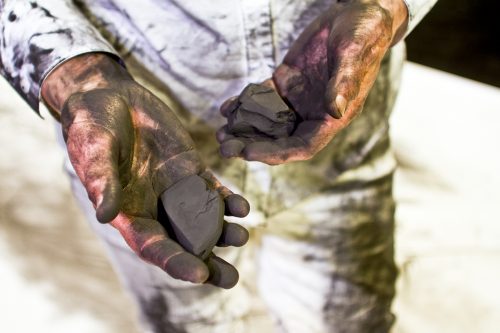
Nina Martin uses charcoal to demonstrate the repetitive movements involved in the dance that ended up providing relief for people with cerebral palsy. Photo by Mark Graham
What Martin never anticipated was the impact this sequence of movements might have on Winters, Angel and others with cerebral palsy. Depending on the area of the brain that sustained injury before or during birth, the movement disorder impacts balance and posture. Some people with cerebral palsy also have significant intellectual disabilities. Most of the participants at Body Shift, a nonprofit in Austin, Texas, that provides classes and workshops in mixed-ability improvisational dance, were on the nonsevere end of the spectrum in terms of intellectual disabilities.
“I knew of Nina and her work from back when I was in a school of dance in Finland,” said Silva Laukkanen, co-founder of Body Shift and an artistic associate with VSA Texas, the state affiliate of an international nonprofit organization on arts and disability.
“When our group was looking for someone to come teach a weekend workshop, we all felt like Nina would be perfect since dance improvisation plays a big role in the way we create performances here,” Laukkanen said. “But she said no.”
“[Martin] actually turned us down twice,” said Celia Hughes, executive director of VSA Texas, whose parent organization is part of the John F. Kennedy Center for the Performing Arts. “She was nervous about never having worked with people with disabilities.”
But by fall 2014, Martin agreed to give the workshop a try. What happened next would change the course of her career.
ReWire at Work
For the first phase of the workshop at Body Shift, Martin had participants, including those who spend most of their days in wheelchairs, lie on the floor.
Following the Fussy Baby work, some of the participants’ retracted limbs were extended farther than ever before during their adult lives. Others experienced a temporary cessation of spasms or noted improvement in their fine motor skills.
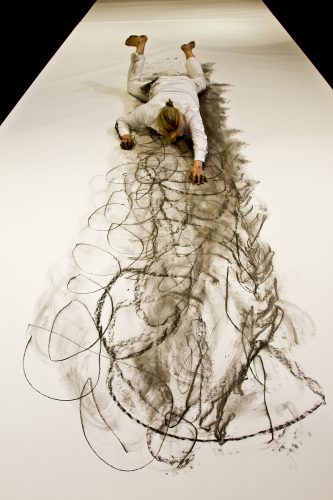
Following the Fussy Baby work, some of the participants’ experienced a temporary cessation of spasms or noted improvement in their fine motor skills. Photo by Mark Graham
“One of the young women, between her CP and the surgeries she has had, pretty much has quadriplegia and cannot do much on her own,” Hughes said. “Following ReWire, she was able to roll over on her own.”
“In Fussy Baby, the mind gets disinterested and goes into this sort of trance,” said Winters, whose legs and feet briefly stopped spasming during Fussy Baby. “It was one of the first moments in my life where I felt like my body was making all of the choices. It was calling the shots.”
Martin returned for another weekend workshop at Body Shift in February 2015. Many of those workshop participants also experienced the same dramatic relief.
Winters typically has a 48-degree curve in her spine, but after her second try at Fussy Baby, her head was “floating above my spine the way it’s supposed to,” she said. “I walk on my toes a lot because my heels never really touch down, but after doing Fussy Baby again, my heels hit the ground and stayed like that for a week.”
“You almost had to see it to believe it,” Laukkanen said. “We did not have any idea why this stillness happened to the dancers with CP, but we felt like we were watching something truly revolutionary.”
Upon returning to TCU, Martin talked with Eric Simanek, the Robert A. Welch professor of chemistry, to strategize on the best methods to conduct her research. “What she accomplishes through this method is remarkable,” said Simanek, who also serves as chair of organic chemistry. “There are not only the physical benefits it provides to the participant, which we are learning more about all the time, but there is also an emotional benefit that could be incalculable.”
Phil Esposito, assistant professor of professional practice in kinesiology, also helped with Martin’s research study. “My contribution was to help with objective measurement,” he said. “We needed to design a study that would help us quantify what we were hearing from the people with CP themselves — that ReWire causes improvement in the way they move, even if for a short time.”
Group Effort
Martin handpicked four students for an honors class called Dance and Cerebral Palsy with the expressed intention of studying the impact of ReWire on people participating in the Body Shift workshops in Austin.
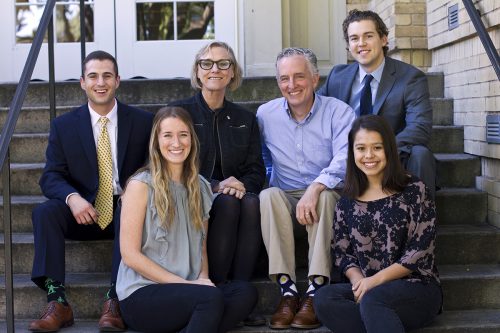
Some of Nina Martin’s research team: front row, from left, Heather McKay and Amelia Bachofen. Back row surrounding Nina Martin, from left, Ben Moran, Eric Simanek and Martin Ptak. Photo by Mark Graham
“I suggested she videotape the participants and use the images for drawing and then measuring angles of joints as part of preliminary evidence that ReWire really works,” said Rita Patterson, director of research and professor of manipulative medicine at the University of North Texas Health Science Center. The biomedical engineer, who has years of experience working with people living with cerebral palsy, consulted on the study.
Martin and her honors students conducted evaluations with workshop participants that included the PROMIS Physical Function Instrument, a self-assessment that looks at dexterity, mobility and activities of daily living. Workshop participants also took the Purdue Pegboard Test, which measures coordination and dexterity in hands, fingers and arms.
“When I first came into the class, I wondered how dance could actually help someone with cerebral palsy,” said Martin Ptak ’19. “But once we started gathering the data, there was this eureka moment when it all became concrete rather than just some abstract idea.”
Before the 2017 workshop, the team mounted four video cameras at 90-degree angles, forming a square around each participant. A fifth camera was positioned above the individual.
Martin and her students analyzed the video with Kinovea, motion-analysis software often used by elite athletes as part of their training regimens. The researchers measured the range of motion of various joints, including shoulder, knee, hip, elbow and wrist.
“Each joint was measured by one of us at least twice,” said Heather McKay, a senior modern dance major. “In class we kept going over the data and throwing out ideas, like why does this work and how does it help people. It’s humbling to work on something with so much potential.”
Amelia Bachofen, a senior honors modern dance major, said, “Seeing the data that showed the trend of improvement in their mobility was a turning point for me. What we are doing is meaningful and impacts people. And it has the potential to help so many more.”
Theories and Practice
In July 2018, Martin and her students presented their findings at Movementis, an annual international conference focused on movement and cognition for medical professionals, research scientists and professionals engaged in movement-based activities, including physical therapy.
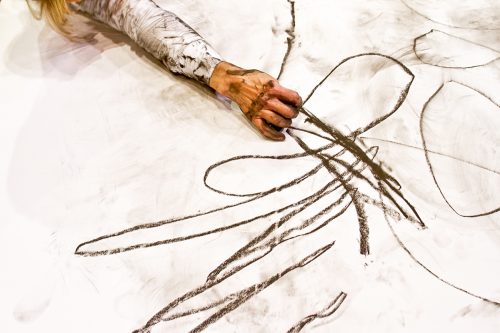
To create her dance, Nina Martin spent hours lying on the floor studying her nervous system. Photo by Mark Graham
“Our research was really well-received at the conference, which explored multifaceted ways of looking at things with the body,” said Ben Moran, a senior honors biology major on the pre-med track. “Dr. Martin and I have talked a lot about how the body is able to repair itself.”
Moran looks forward to using the ReWire technique with children, something Pamela Sherman, a pediatric orthopedic surgeon on staff at Cook Children’s Medical Center in Fort Worth, is planning with Martin.
“Nina’s research isn’t the typical stuff that you think about but is easily applicable to a kid,” Sherman said. “Part of the difference between an adult and kid population is that we have no idea what ReWire could do for the plastic or developing brain.”
Neuroplasticity is “the ability of the brain to modify its connections or rewire itself,” Esposito explained. “It can process sensory and motor signals in parallel, and many neural pathways can replicate another’s function.
“This is good because if part of the brain is damaged, some signals can be rerouted along a different pathway,” the kinesiology professor said. “Fussy Baby technique or random movements can potentially stimulate other pathways and help redirect those signals.”
In the meantime, Martin has found other ways to make art that dovetails with her research. In 2018, she worked with Roma Flowers, associate professor of professional practice in dance, to create a video of a performer with cerebral palsy based on ReWire.
“There is more and more research about art and its connection to healing, which is something that has been present ever since there has been art,” said Flowers, who specializes in lighting design and dance production. “We assume there is spiritual healing and emotional healing when we make art, but Nina’s work is showing us the very real connection between art and actual physical healing.”

Your comments are welcome
Comments
Related reading:
Research + Discovery
Making the Mind-Body Connection in Dance
Jessica Zeller values student input and critical thinking over rote mimicry.
Features
Creativity Boosts Your Brain
Art helps the brain stay healthy, which leads to a thriving life.
Research + Discovery
Using Art to Treat Illness and Trauma
Amanda Allison and her students at TCU earned acclaim for designing therapeutic art programs.